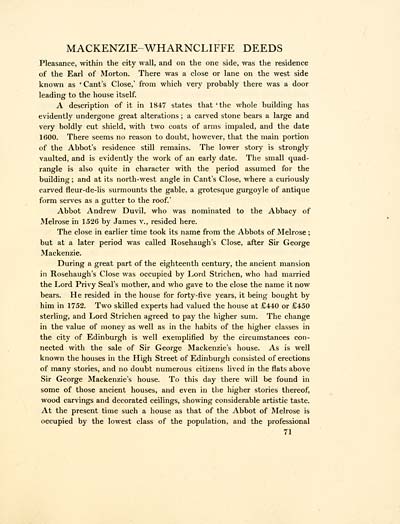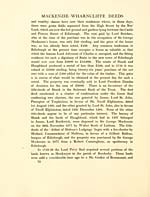Download files
Complete book:
Individual page:
Thumbnail gallery: Grid view | List view

MACKENZIE-WHARNCLIFFE DEEDS
Pleasance, within the city wall, and on the one side, was the residence
of the Earl of Morton. There was a close or lane on the west side
known as ' Cant's Close,' from which very probably there was a door
leading to the house itself.
A description of it in 1847 states that 'the whole building has
evidently undergone great alterations ; a carved stone bears a large and
very boldly cut shield, with two coats of arms impaled, and the date
1600. There seems no reason to doubt, however, that the main portion
of the Abbot's residence still remains. The lower story is strongly
vaulted, and is evidently the work of an early date. The small quad-
rangle is also quite in character with the period assumed for the
building ; and at its north-west angle in Cant's Close, where a curiously
carved fleur-de-lis surmounts the gable, a grotesque gurgoyle of antique
form serves as a gutter to the roof.'
Abbot Andrew Duvil, who was nominated to the Abbacy of
Melrose in 1526 by James v., resided here.
The close in earlier time took its name from the Abbots of Melrose ;
but at a later period was called Rosehaugh's Close, after Sir George
Mackenzie.
During a great part of the eighteenth century, the ancient mansion
in Rosehaugh's Close was occupied by Lord Strichen, who had married
the Lord Privy Seal's mother, and who gave to the close the name it now
bears. He resided in the house for forty-five years, it being bought by
him in 1752. Two skilled experts had valued the house at £440 or £450
sterling, and Lord Strichen agreed to pay the higher sum. The change
in the value of money as well as in the habits of the higher classes in
the city of Edinburgh is well exemplified by the circumstances con-
nected with the sale of Sir George Mackenzie's house. As is well
known the houses in the High Street of Edinburgh consisted of erections
of many stories, and no doubt numerous citizens lived in the flats above
Sir George Mackenzie's house. To this day there will be found in
some of those ancient houses, and even in the higher stories thereof,
wood carvings and decorated ceilings, showing considerable artistic taste.
At the present time such a house as that of the Abbot of Melrose is
occupied by the lowest class of the population, and the professional
71
Pleasance, within the city wall, and on the one side, was the residence
of the Earl of Morton. There was a close or lane on the west side
known as ' Cant's Close,' from which very probably there was a door
leading to the house itself.
A description of it in 1847 states that 'the whole building has
evidently undergone great alterations ; a carved stone bears a large and
very boldly cut shield, with two coats of arms impaled, and the date
1600. There seems no reason to doubt, however, that the main portion
of the Abbot's residence still remains. The lower story is strongly
vaulted, and is evidently the work of an early date. The small quad-
rangle is also quite in character with the period assumed for the
building ; and at its north-west angle in Cant's Close, where a curiously
carved fleur-de-lis surmounts the gable, a grotesque gurgoyle of antique
form serves as a gutter to the roof.'
Abbot Andrew Duvil, who was nominated to the Abbacy of
Melrose in 1526 by James v., resided here.
The close in earlier time took its name from the Abbots of Melrose ;
but at a later period was called Rosehaugh's Close, after Sir George
Mackenzie.
During a great part of the eighteenth century, the ancient mansion
in Rosehaugh's Close was occupied by Lord Strichen, who had married
the Lord Privy Seal's mother, and who gave to the close the name it now
bears. He resided in the house for forty-five years, it being bought by
him in 1752. Two skilled experts had valued the house at £440 or £450
sterling, and Lord Strichen agreed to pay the higher sum. The change
in the value of money as well as in the habits of the higher classes in
the city of Edinburgh is well exemplified by the circumstances con-
nected with the sale of Sir George Mackenzie's house. As is well
known the houses in the High Street of Edinburgh consisted of erections
of many stories, and no doubt numerous citizens lived in the flats above
Sir George Mackenzie's house. To this day there will be found in
some of those ancient houses, and even in the higher stories thereof,
wood carvings and decorated ceilings, showing considerable artistic taste.
At the present time such a house as that of the Abbot of Melrose is
occupied by the lowest class of the population, and the professional
71
Set display mode to:
![]() Universal Viewer |
Universal Viewer | ![]() Mirador |
Large image | Transcription
Mirador |
Large image | Transcription
Images and transcriptions on this page, including medium image downloads, may be used under the Creative Commons Attribution 4.0 International Licence unless otherwise stated. ![]()
| Histories of Scottish families > Ancient deeds and other writs in the Mackenzie-Wharncliffe charter-chest > (97) Page 71 |
|---|
| Permanent URL | https://digital.nls.uk/95524529 |
|---|
| Description | A selection of almost 400 printed items relating to the history of Scottish families, mostly dating from the 19th and early 20th centuries. Includes memoirs, genealogies and clan histories, with a few produced by emigrant families. The earliest family history goes back to AD 916. |
|---|

